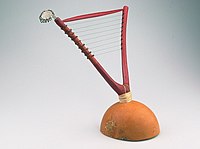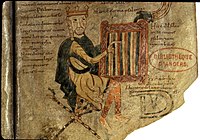 Liberian zither with calabash resonator. Called a "harp" by its collector; however, on a harp the "plane of the strings lies perpendicular to the resonator's surface." The strings running parallel to the gourd resonator make this a frame zither under Hornbostel-Sachs. | |
| String instrument | |
|---|---|
| Other names | belly harp |
| Classification | Plucked string instrument |
| Hornbostel–Sachs classification | 316
|
| Inventor(s) | folk instrument |
Frame zither is a class of musical instrument (subset of zither) within the Hornbostel-Sachs classification system for a type of simple chordophone (stringed instrument), in which the body of the instrument is made from a frame.[1]
Frame zithers are musical instruments in which strings are strung across an open frame.[2] They could be similar to harps and psalteries which can also have strings stretched across frames. However, in harps the strings run from the frame to a resonating table embedded into the frame on the frame's other end. Psalteries may also have a frame, but behind the strings (parallel to them) is a board, the top of a box which acts as a resonator.
Musicians may add a resonator as is done with a bow harp; they can attach or put the instrument into a calabash gourd or a ceramic pot.[3]
Under the Hornbostel-Sachs system of musical instrument classification, any frame with strings stretched across, and without a built in resonator, would count as a frame zither. In musical instrument encyclopedias, however, there are few or no examples of frame zithers except those found in Africa. Potential examples include medieval European illustrations; these however are not clear and could equally illustrate forms of harps or psalteries.[1]
- ^ a b von Hornbostel, Erich M.; Sachs, Curt (March 1961). "Classification of Musical Instruments: Translated from the Original German by Anthony Baines and Klaus P. Wachsmann". The Galpin Society Journal. 14: 20–21. doi:10.2307/842168. JSTOR 842168.
[Example:] Perhaps in medieval psalteries.
- ^ Sadie, Stanley, ed. (1984). "Frame zither". The New Grove Dictionary of Musical Instruments. p. 794. Volume 1.
- ^ Ulrich Wegner (1984). Afrikanische Saiteninstrumente. Veröffentlichungen des Museums für Völkerkunde Berlin. Neue Folge 41. Abteilung Musikethnologie V (translation: African string instruments. Publications of the Museum for Ethnology, Berlin. New series 41, Department of Ethnic Music V. Berlin: Staatliche Museen Preußischer Kulturbesitz. pp. 76–81.

